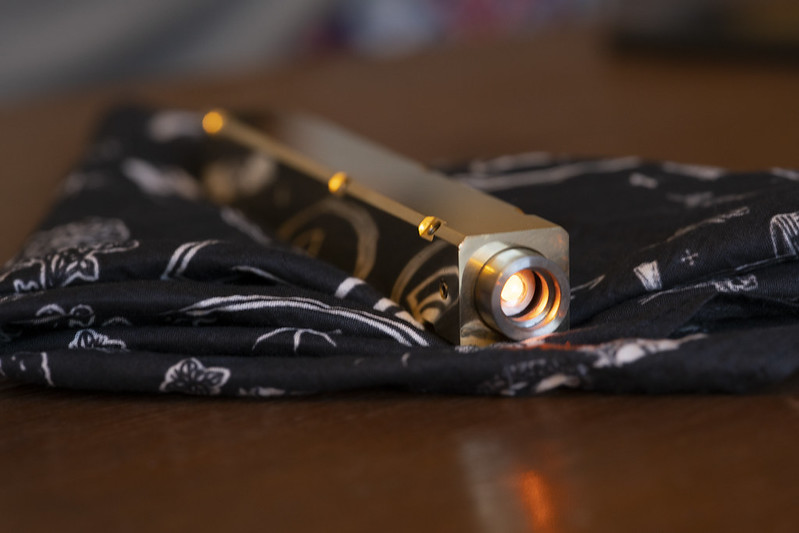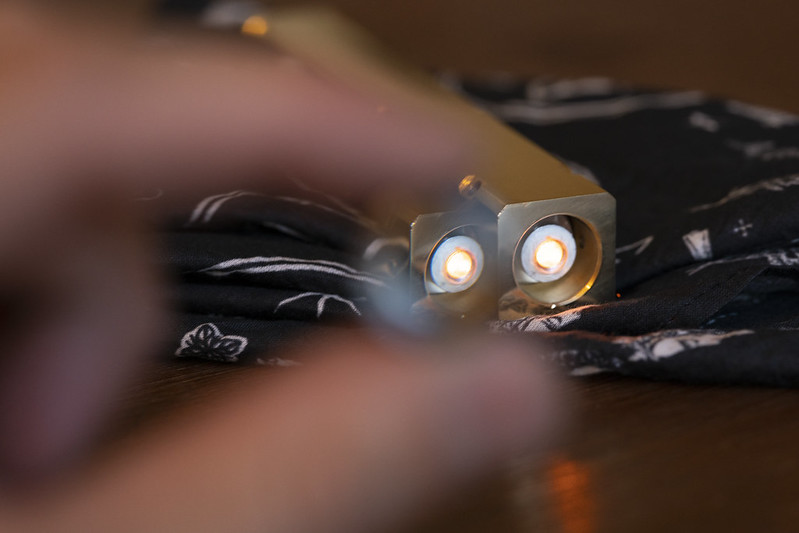- Joined
- Sep 16, 2007
- Messages
- 3,667
- Points
- 113
Last year I ordered a 589 nm laser module from CNI with plans for something special.
Those of you who know my work will know I generally prefer to build simple pens.
However, I have lots of plans for more unique designs. My main limitation is the work space and tools needed to produce them.
Fortunately, Trinh Hong Phuoc was willing to make one of my designs to specification.
First, I'll say it was a pleasure to work with Trinh. He worked with me on some of the details of the design, such as choosing quality materials that he had available.
Although the turnaround between ordering and receiving the item took a while, it was worth it. The host I received is machined well despite some minor pitting here and there.
With that out of the way...

The host is machined from Copper-Nickel alloy and the aperture cap is machined from Titanium.
Copper-Nickel is a good material for heat-sinking but is superior to brass, copper, and bronze for its corrosion resistance. My original plan was to use stainless steel for the aperture cap but since Titanium was available, I decided that was the cooler option. I lightly polished the main flat surfaces and kept the edges matte for contrast.


The idea behind the design was to create something that is highly modular. That is, the flat surfaces make it easy to design and attach accessories and engrave designs. I intend to use this laser as a pointer for astronomy, probably at the occasional scientific conference, and while teaching.
I plan to do a little engraving to make the host a bit more interesting but it will keep the industrial aesthetic. I am designing some components that will allow external power source rather than battery operation and an external miniature fan-cooled heat-sink that will be mounted to the host.

The host is designed for CR123A batteries. With the 589 nm module, only one battery is used. However, with some other module I will make in the future, two cells can be used for more flexibility. The external heat-sink will allow longer run-times, especially for higher-power modules which can be swapped in quite easily - but more on that another time...
The tail cap is hand made. I bored out the dimensions inside for a constant on-off clicky switch and made the button from stainless steel rod.
The module is a 30 mW 589 nm CNI unit. Unfortunately, it only will make 30 mW on a very good day but seems to be happy around 20-25 mW. The module also suffers from a very high degree of beam deflection. The beam exits the collimating lens at a 5.3 degree angle - by far the worst I've seen from a DPSS laser.
To correct this, I installed a very nice AR-coated wedge prism that deflects an incident beam of 589 nm by about 6 degrees. This means there is still a small amount of deflection after correction, but it is a vast improvement. Since Edmund doesn't stock wedge prisms in 10 mm diameter, I had to use a diamond file to re-shape the prism to fit into the aperture cap. The effect of the wedge prism is shown below:

I also had some issues with the CNI driver. It has some odd behavior which I won't go into detail about. Let it suffice to say I spent the better part of an evening trying to resolve some weird issues. Perhaps one day I can replace the driver.
Overall, it turned out well. Now I can officially update my signature to include 589nm.
What do you think?
Those of you who know my work will know I generally prefer to build simple pens.
However, I have lots of plans for more unique designs. My main limitation is the work space and tools needed to produce them.
Fortunately, Trinh Hong Phuoc was willing to make one of my designs to specification.
First, I'll say it was a pleasure to work with Trinh. He worked with me on some of the details of the design, such as choosing quality materials that he had available.
Although the turnaround between ordering and receiving the item took a while, it was worth it. The host I received is machined well despite some minor pitting here and there.
With that out of the way...

The host is machined from Copper-Nickel alloy and the aperture cap is machined from Titanium.
Copper-Nickel is a good material for heat-sinking but is superior to brass, copper, and bronze for its corrosion resistance. My original plan was to use stainless steel for the aperture cap but since Titanium was available, I decided that was the cooler option. I lightly polished the main flat surfaces and kept the edges matte for contrast.


The idea behind the design was to create something that is highly modular. That is, the flat surfaces make it easy to design and attach accessories and engrave designs. I intend to use this laser as a pointer for astronomy, probably at the occasional scientific conference, and while teaching.
I plan to do a little engraving to make the host a bit more interesting but it will keep the industrial aesthetic. I am designing some components that will allow external power source rather than battery operation and an external miniature fan-cooled heat-sink that will be mounted to the host.

The host is designed for CR123A batteries. With the 589 nm module, only one battery is used. However, with some other module I will make in the future, two cells can be used for more flexibility. The external heat-sink will allow longer run-times, especially for higher-power modules which can be swapped in quite easily - but more on that another time...
The tail cap is hand made. I bored out the dimensions inside for a constant on-off clicky switch and made the button from stainless steel rod.
The module is a 30 mW 589 nm CNI unit. Unfortunately, it only will make 30 mW on a very good day but seems to be happy around 20-25 mW. The module also suffers from a very high degree of beam deflection. The beam exits the collimating lens at a 5.3 degree angle - by far the worst I've seen from a DPSS laser.
To correct this, I installed a very nice AR-coated wedge prism that deflects an incident beam of 589 nm by about 6 degrees. This means there is still a small amount of deflection after correction, but it is a vast improvement. Since Edmund doesn't stock wedge prisms in 10 mm diameter, I had to use a diamond file to re-shape the prism to fit into the aperture cap. The effect of the wedge prism is shown below:

I also had some issues with the CNI driver. It has some odd behavior which I won't go into detail about. Let it suffice to say I spent the better part of an evening trying to resolve some weird issues. Perhaps one day I can replace the driver.
Overall, it turned out well. Now I can officially update my signature to include 589nm.
What do you think?
Last edited:



